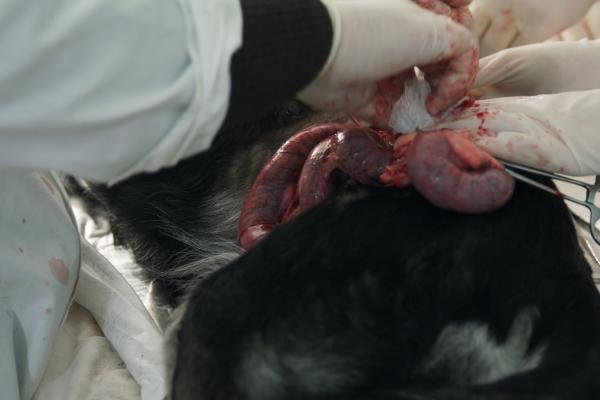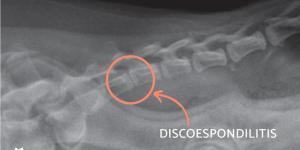Pyometra in Dogs - Causes, Symptoms and Treatment



See files for Dogs
Canine pyometra is a type of uterine infection which is most commonly associated with dogs. Although the direct cause of the uterine infection is bacteria, pyometra is a result of structural and hormonal changes which occur in the uterus of the dog. These changes result in the uterine tissue becoming more susceptible to infection as it has weaker defenses against bacteria. The uterine infection causes a reaction in the dog's immune system which creates pus to fight the bacteria. Where this buildup of pus occurs can lead to different types of pyometra in dogs.
Since pyometra is a uterine infection, it only occurs in females dogs which have not been spayed. This is because spayed dogs have their uterus removed. AnimalWised explains pyometra in dogs and its causes, symptoms and treatment so you can have a better idea if your dog is affected.
What is pyometra in dogs?
Canine pyometra is a serious and potentially life-threatening condition that affects female dogs. It almost exclusively affects dogs which are unspayed. It is a canine uterine infection characterized by the accumulation of pus within the uterus. Pyometra typically occurs during or after a female dog's heat cycle. However, it can occur when a dog is pregnant, posing a potentially very serious complication in dog pregnancy.
During the heat cycle, the hormone fluctuations in a female dog's body prepare the uterus for potential pregnancy. If pregnancy does not occur, the uterine lining can become thickened, creating an ideal environment for bacteria to multiply. Bacteria can then enter the uterus through the cervix, leading to infection.
Pyometra in dogs is a type of empyema. This means it causes a buildup of pus inside the uterus itself. In the next section, we explain why the location of this buildup can affect the clinical picture of the dog.
Types of pyometra in dogs
There are two types of pyometra in dogs, open pyometra and closed pyometra. These terms describe the status of the cervix and the ability of pus to drain from the uterus. Here are the differences between the two types:
Open canine pyometra
- In open pyometra, the cervix remains partially open, allowing some discharge to flow out of the uterus. This can result in noticeable vaginal discharge, which may be bloody, pus-like or have a foul odor.
- The open cervix allows bacteria to enter the uterus, leading to infection and the accumulation of pus.
- Dogs with open pyometra may show signs of illness, such as increased thirst and urination, lethargy, loss of appetite, abdominal swelling and fever.
- The presence of vaginal discharge in open pyometra may alert dog owners to seek veterinary attention earlier, as the symptoms are more evident.
Closed canine pyometra
- In closed pyometra, the cervix is tightly closed, preventing the drainage of pus from the uterus.
- Without the ability to drain, the pus accumulates within the uterus, leading to distension and enlargement of the uterus.
- Closed pyometra can be more challenging to diagnose as there may be no obvious vaginal discharge. However, dogs may still exhibit generalized signs of illness, such as lethargy, loss of appetite, abdominal swelling and fever.
- The lack of vaginal discharge in closed pyometra can delay detection and result in a more critical condition by the time it is diagnosed.
- Closed pyometra poses a higher risk of complications, as the trapped pus can lead to increased pressure within the uterus, potentially causing uterine rupture or toxic shock.
Both open and closed pyometra are considered serious conditions requiring immediate veterinary attention. Prompt diagnosis and treatment are essential to prevent severe complications, including systemic infection, sepsis, organ failure and even death.
Understanding the differences between open and closed pyometra can help dog owners recognize the potential signs of the condition and seek veterinary care promptly. In turn, this can improve the chances of a successful outcome for their dogs.

Causes of pyometra in dogs
The cause of pyometra is various bacteria which can cause a cnaine uterine infection. The most common bacterium responsible for canine pyometra is E. coli[1]. All unspayed female dogs are susceptible to pyometra, but certain factors can increase the likelihood of developing this uterine infection. Here are some factors that make some dogs more conducive to pyometra compared to others:
- Age: dogs over the age of six are at typically a higher risk of developing pyometra. This is because the uterine tissues may undergo age-related changes that make them more susceptible to infection.
- Hormonal influence: hormonal fluctuations during the estrus (heat) cycle in dogs play a significant role in pyometra development. Dogs that experience regular or prolonged heat cycles have a higher risk of developing the condition. Furthermore, dogs that receive hormone-based treatments to control estrus (such as progesterone) may also be more prone to pyometra.
- Reproductive history: dogs that have had previous pregnancies, false pregnancies, or have undergone repeated heat cycles without being bred have an increased risk of pyometra. These factors contribute to changes in the uterine lining, making it more favorable for bacterial growth and infection.
- Breed predisposition: certain dog breeds have a higher predisposition to pyometra. Breeds such as the Rottweiler, Golden Retriever, Bernese Mountain Dog and Cavalier King Charles Spaniel are more commonly affected. The reasons for breed predisposition are not fully understood but may be related to hormonal and anatomical factors. Learn about other conditions which are considered common diseases of the German Shepherd.
- Genetic factors: there may be a genetic component involved in the development of pyometra. Some dogs may have a genetic predisposition that makes them more susceptible to uterine infections.
- Poor immune function: dogs with compromised immune systems, either due to underlying diseases or medications that suppress the immune response, are more susceptible to infections, including pyometra.
Also known as an ovariohysterectomy, spaying is the most effective way to prevent pyometra. Spaying removes the uterus and eliminates the risk of developing this condition. Spaying also eliminates the risk of other reproductive diseases, such as ovarian tumors and mammary gland cancer.
What are the most common symptoms of canine pyometra?
The most common symptoms of canine pyometra vary depending on the type of pyometra. Here are the specific symptoms associated with each type:
Open canine pyometra
- Vaginal discharge: dogs with open pyometra often exhibit a noticeable vaginal discharge. The discharge may vary in appearance, including being bloody, pus-like, or having a foul odor.
- Increased thirst and urination: may drink more water than usual and urinate more frequently.
- Lethargy: may appear weak, tired and lack energy.
- Loss of appetite: dogs may show a decreased interest in food or refuse to eat altogether.
- Abdominal swelling: the abdomen may appear enlarged or distended.
- Fever: may have an elevated body temperature.
Closed Pyometra
- Lethargy: dogs with closed pyometra often display a general lack of energy and may seem weak or uninterested in normal activities.
- Loss of appetite: may have a decreased appetite or refuse to eat entirely.
- Abdominal swelling: the abdomen may become distended or appear enlarged.
- Vomiting: some dogs with closed pyometra may experience episodes of vomiting.
- Increased thirst and urination: may drink more water than usual and urinate more frequently.
- Fever: may have an elevated body temperature.
It's important to note that these symptoms can vary in severity and may not always be present. Some dogs may show only subtle signs of illness. Others may exhibit more pronounced symptoms. Dogs with closed pyometra may not have a noticeable vaginal discharge, which can make the condition more difficult to detect.
Diagnosis of pyometra in dogs
The diagnosis of pyometra in dogs involves a combination of clinical evaluation, physical examination, and diagnostic tests. Here's an overview of the diagnostic process for canine pyometra:
- Clinical evaluation: he veterinarian will begin by gathering information about the dog's medical history, including reproductive history and any current symptoms or changes in behavior. This helps provide important clues and context for the diagnosis.
- Physical examination: a thorough physical examination will be conducted to assess the overall health of the dog. The veterinarian will palpate the abdomen to check for any signs of swelling or discomfort.
- Imaging: diagnostic imaging techniques, such as ultrasound or X-rays, may be utilized to evaluate the size, shape, and contents of the uterus. These imaging modalities can help identify signs of uterine enlargement, fluid accumulation, or other abnormalities.
- Blood tests: blood work, including a complete blood count (CBC) and biochemical profile, may be performed to assess the overall health of the dog and check for any signs of infection or organ dysfunction. Learn more with our guide to understanding a dog's blood test.
- Vaginal cytology: a sample of vaginal discharge may be collected and examined under a microscope. This can help identify the presence of inflammatory cells and bacteria, providing evidence of infection.
- Hormone testing: in some cases, hormonal assays may be conducted to evaluate the hormonal balance and rule out other reproductive disorders.
These diagnostic procedures help the veterinarian determine the presence of pyometra and its severity. The type of pyometra (open or closed) may also be identified during the examination and testing. Once a diagnosis is confirmed, the veterinarian will discuss treatment options and develop a suitable plan to address the condition. Pyometra is a serious condition that requires immediate veterinary care.

Treatment of pyometra in dogs
The treatment options for pyometra in dogs typically involve addressing the infection and removing the infected uterus. The common treatment approaches for canine pyometra usually follow a particular process which we explain below:
- Emergency stabilization: before proceeding with definitive treatment, dogs with pyometra may require initial stabilization. This can include administration of intravenous fluids to address dehydration and electrolyte imbalances. Antibiotics such as amoxicillin for dogs may also be administered to control the spread of infection and stabilize the dog's condition.
- Surgical intervention: the primary treatment for pyometra is surgical removal of the infected uterus. It is essentially the same as an ovariohysterectomy (spaying). The surgery removes both the ovaries and the uterus, eliminating the source of the infection. Spaying is typically performed under general anesthesia, and the surgical incision is closed with sutures or staples. Below is a video of the pyometra surgical procedure.
- Supportive care: dogs with pyometra often require supportive care following surgery. This can include continued administration of intravenous fluids, pain management, and antibiotics to prevent post-operative infection. Additional medications may be prescribed to address any concurrent issues or complications.
- Post-operative monitoring: after surgery, dogs are closely monitored for a period of time to ensure proper recovery. This includes monitoring vital signs, incision healing, and overall well-being. Pain management and medication administration are continued as necessary.
It's important to note that pyometra is a serious condition. Prompt veterinary intervention is crucial for successful treatment. Delayed or inadequate treatment can result in life-threatening complications.
In some cases, medical management of pyometra may be considered as an alternative to surgery, particularly in valuable breeding dogs. This approach involves using medications to address the infection and induce uterine contractions to expel the pus. However, medical management carries higher risks and is typically reserved for specific cases under close veterinary supervision.
Overall, surgical removal of the infected uterus (spaying) is the most common and effective treatment for pyometra, ensuring the dog's recovery and preventing the recurrence of the condition.
Although successfully spayed dogs cannot develop pyometra, there are some cases when a uterine remnant cam result in infection. This is when not all of the uterine or ovarian tissue has been removed. It results in something known as stump pyometra[2]. We explain more in our article on whether spayed dogs can get pyometra.

This article is purely informative. AnimalWised does not have the authority to prescribe any veterinary treatment or create a diagnosis. We invite you to take your pet to the veterinarian if they are suffering from any condition or pain.
If you want to read similar articles to Pyometra in Dogs - Causes, Symptoms and Treatment, we recommend you visit our Bacterial diseases category.
1. Xavier, R. G. C., da Silva, P. H. S., Trindade, H. D., Carvalho, G. M., Nicolino, R. R., Freitas, P. M. C., & Silva, R. O. S. (2022). Characterization of Escherichia coli in Dogs with Pyometra and the Influence of Diet on the Intestinal Colonization of Extraintestinal Pathogenic E. coli (ExPEC). Veterinary sciences, 9(5), 245. https://doi.org/10.3390/vetsci9050245
2. Ehrhardt, C., Odunayo, A., Pascutti, K., Carvajal, J., Ham, K., & Harris, A. N. (2023). Stump pyometra in a spayed female dog secondary to tamoxifen. Veterinary medicine and science, 9(1), 47–52. https://doi.org/10.1002/vms3.1041







